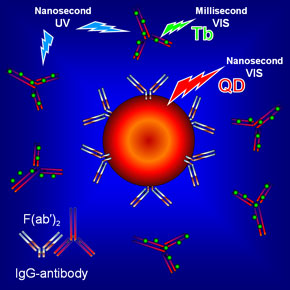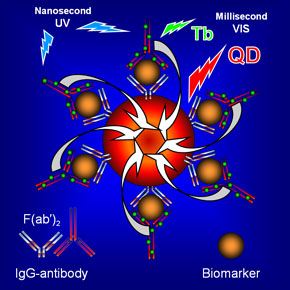| Posted: Feb 17, 2010 | |
Quantum dot biosensors for ultrasensitive multiplexed diagnostics |
|
| (Nanowerk Spotlight) The development of fast, portable point-of-care diagnostics will address the diagnostic problems that many doctors and hospitals are facing today. Rather than taking multiple blood samples, sending them to test labs and then waiting for the results, point-of-care diagnostic devices are decentralized diagnostic tools that allow doctors a fast and often multiparametric analysis. Such devices would be especially valuable for the quick detection of various infectious disease. | |
| In many diagnostic processes, the detection of several protein markers is required. Rather than performing several sequential analysis steps, a multiplexed approach allows the simultaneous measurement of multiple biomarkers from the same blood sample. The convergence of nanotechnology, microtechnology, microfluidics, photonics, signal processing, and proteomics allows for the development of increasingly sophisticated and effective multiplexed point-of-care diagnostic devices (see "An early example of nanotechnology's convergence with other technologies"). | |
| The detection of protein biomarkers can done with an optical multiplexing approach that uses dye particles of different colors. In contrast to conventional fluorescence dyes, quantum dots generate a much more powerful fluorescent signal which provides a large increase in sensitivity compared to other methods. Quantum dots are also available in multiple colors, allowing the investigators to tag each antibody with a uniquely colored quantum dot. | |
| Researchers have now demonstrated a novel and fast quantum dot-based FRET (Förster resonance energy transfer) technique that is suitable for multiplexed ultrasensitive detection. | |
| "Our multiplexed technology offers the significant benefits of simultaneously measuring different biocomplexes with extremely high sensitivity, reproducibility, and speed," Niko Hildebrandt tells Nanowerk. "Simultaneous FRET to several different quantum dots has never been shown before. Here we demonstrate simultaneous FRET to five different quantum dots with emission maxima at 529, 565, 604, 653, and 712 nm." | |
| Hildebrandt, head of the recently established group of NanoPolyPhotonics at the Fraunhofer Institute for Applied Polymer Research and also the coordinator of the European Nanognostics project, emphasizes that their assay combines multiplexed detection and very high sensitivity, offering large benefits compared to conventional diagnostic assays. | |
  |
|
| Quantum dot before and after biomarker binding. Antibodies labeled with Tb-complexes (green dots) and quantum dots (QD) labeled with different antibodies bind to a specific biomarker. This enables the close proximity between Tb-complex and QD and FRET from Tb to QD becomes possible. Due to this FRET, a new millisecond luminescence decay of QDs is achieved which is specific for the FRET system and thus for the biomarker. The time-gated intensity is then proportional to the biomarker concentration. For different biomarkers one uses different antibodies and QDs. The rest stays the same. (Images: Dr. Hildebrandt, Fraunhofer Institute for Applied Polymer Research) | |
| "There are many examples of quantum dot-based bioassays in the literature but usually they are not so extremely sensitive" says Hildebrandt. "Our motivation was to demonstrate the use of our system for multiparametric assays of biomarkers. We had hoped that the sensitivity would be comparable to the standard assays – but now it is even better!" | |
| The scientific core of the team's findings (Hildebrandt was working with researchers from the University of Potsdam, CNRS in Strasbourg, and Lumiphore Inc) is the efficient energy transfer (FRET) between one luminescent terbium complex and several semiconductor quantum dots. In previous work ("Quantum Dots as Efficient Energy Acceptors in a Time-Resolved Fluoroimmunoassay"), the researchers have already shown, for the first time, that efficient FRET to quantum dots is possible at all. Since then, they have improved and optimized their technique and conducted more investigations in the direction of multiplexed detection. | |
| Hildebrandt notes that there are four main main advantages of FRET with their system are 1) The possibility of measuring long distances (due to the extremely large F?rster radii achieved - the distance where FRET is 50% efficient - of more than 10 nm) where they can break the commonly known limit of 10 nm; 2) The reduction of background signal (e.g. from sample autofluorescence) due to time-gating, which is possible due to the use of terbium complexes with long excited state lifetimes; 3) The possibility of using several different quantum dots with on terbium complex for multiplexing; 4) The very high sensitivity. | |
| "From the FRET point of view our technology allows to suppress the very strong fluorescence of directly excited quantum dots" says Hildebrandt. "This means that when we excite our samples with the laser there will be many terbium complexes in the excited state but even more quantum dots (ca. 30,000 times more if you take similar concentrations). At this point of time FRET to quantum dots is very inefficient because the FRET-acceptors (the quantum dots) must be in the ground state. Due to the long excited state lifetimes (milliseconds) of terbium we can simply wait until all quantum dots are back in the ground state and then very efficient FRET is possible." | |
| Going forward, Hildebrandt and his team will try to obtain stable, biocompatible and reproducible highly luminescent quantum dots which have only small protective shells around the main semiconductor nanocrystal and try to efficiently label them to different biomolecules. | |
| "In the Nanognostics project we have joined many well known experts to advance our research field towards this goal" says Hildebrandt. "The market for organic fluorophores, fluorescent proteins etc. for spectroscopy and microscopy is extremely large. If we apply quantum dots to an approved real assay application, these nanocrystals could possibly take a big piece of that cake. In addition to the applied research and the commercial implications, our FRET system is extremely interesting for fundamental energy transfer investigations. And without the profound fundamental knowledge we will have a problem of advancing our field to where we want it to be." | |
| The researchers have published their findings in the January 27, 2010 online edition of Angewandte Chemie International Edition ("Quantum Dot Biosensors for Ultrasensitive Multiplexed Diagnostics"). | |
 By
Michael
Berger
– Michael is author of three books by the Royal Society of Chemistry:
Nano-Society: Pushing the Boundaries of Technology,
Nanotechnology: The Future is Tiny, and
Nanoengineering: The Skills and Tools Making Technology Invisible
Copyright ©
Nanowerk LLC
By
Michael
Berger
– Michael is author of three books by the Royal Society of Chemistry:
Nano-Society: Pushing the Boundaries of Technology,
Nanotechnology: The Future is Tiny, and
Nanoengineering: The Skills and Tools Making Technology Invisible
Copyright ©
Nanowerk LLC
|
|
|
Become a Spotlight guest author! Join our large and growing group of guest contributors. Have you just published a scientific paper or have other exciting developments to share with the nanotechnology community? Here is how to publish on nanowerk.com. |
|
